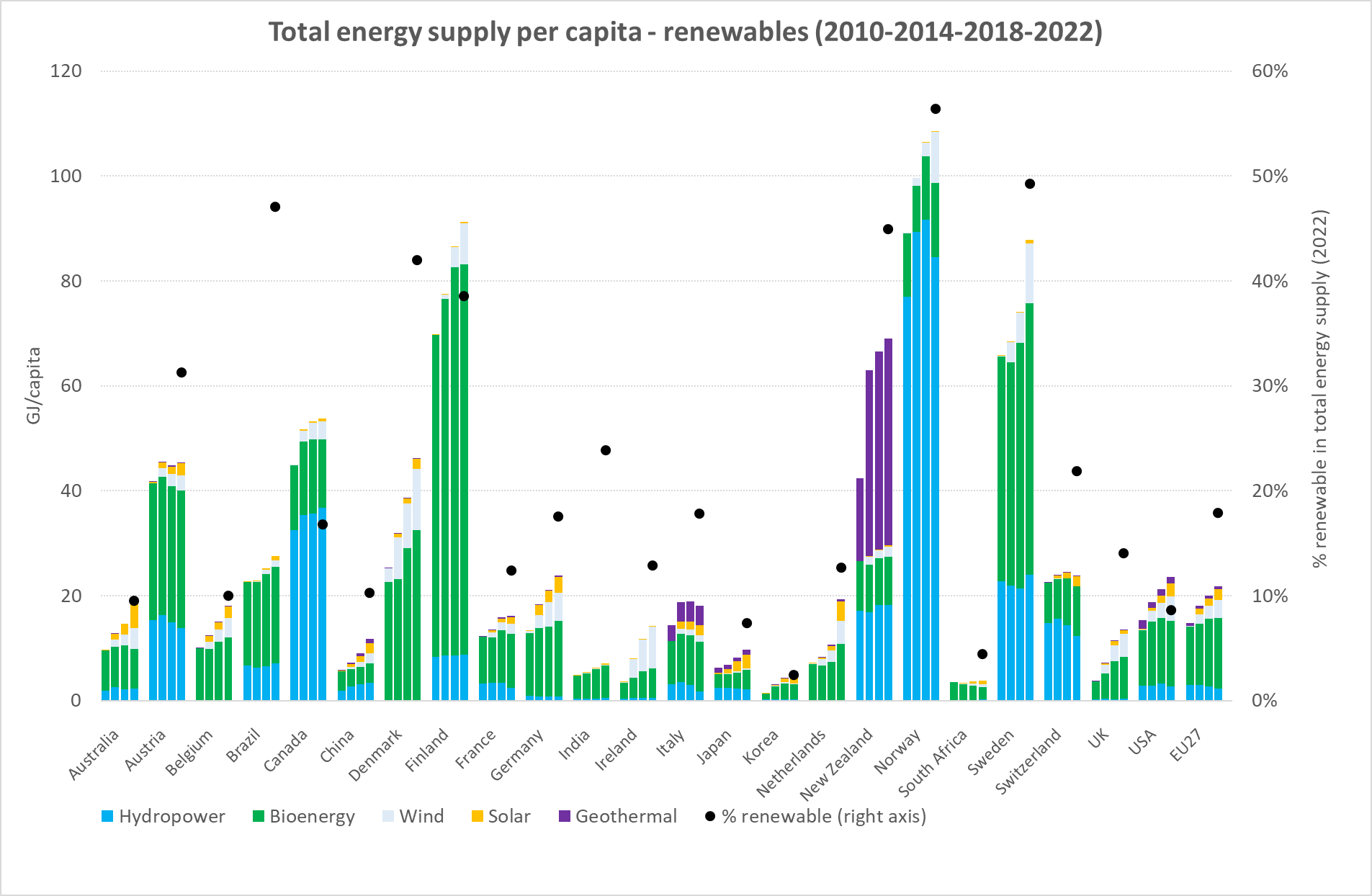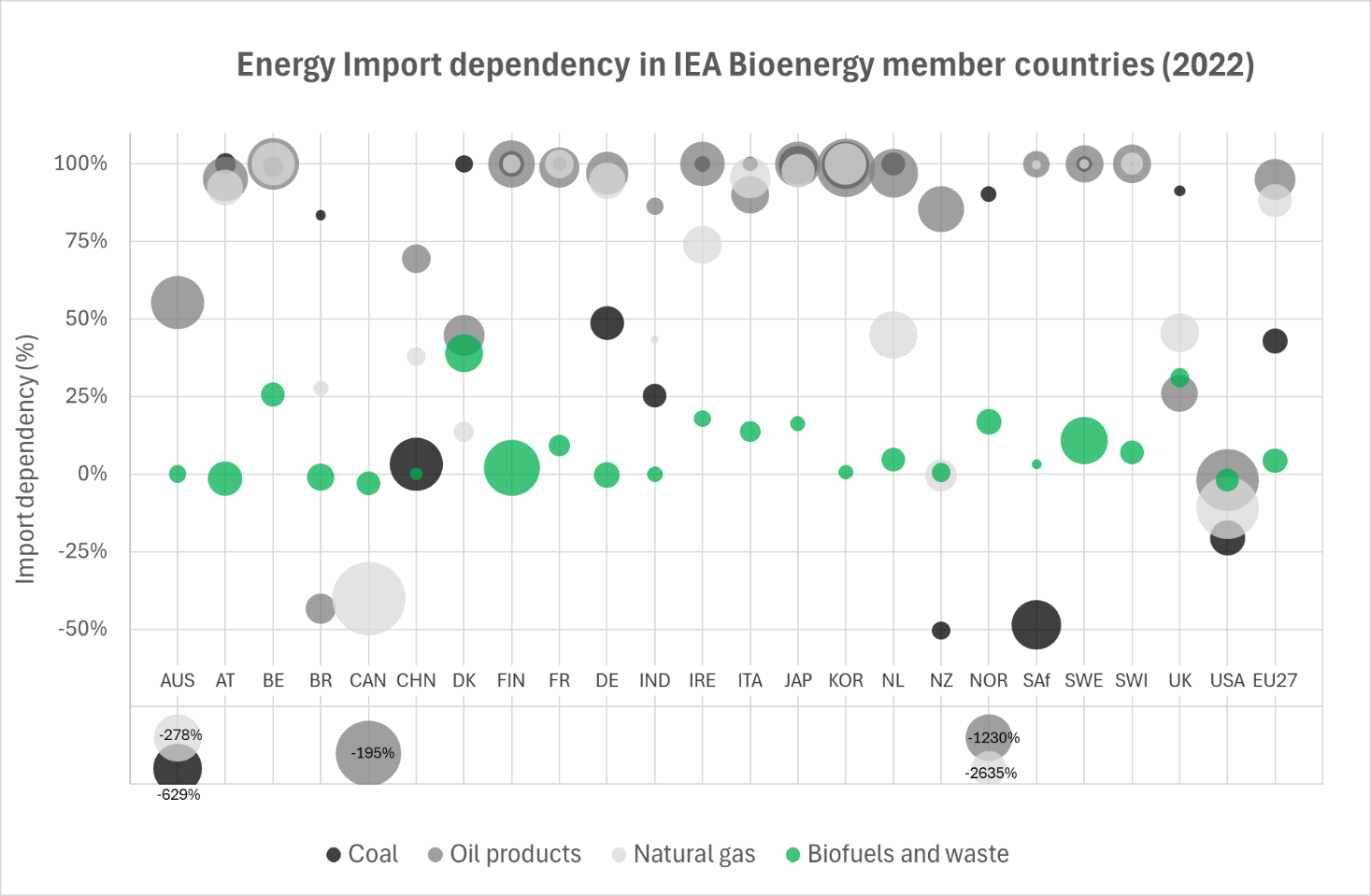The updated IEA Bioenergy Country Reports show the trends of bioenergy in the IEA Bioenergy member countries up to 2022, highlighting the role of bioenergy in their energy mix. The analysis is based on data from the 2024 IEA World Energy Balances and Renewables Information, combined with input provided by the IEA Bioenergy Executive Committee members. The final report provides a comparative overview of the results for different countries.
Main highlights of the summary report
Shares of different types of fuels
Oil has a substantial and relatively stable role in all countries, particularly in relation to its use in transport. Covid had an important impact on oil consumption in 2020, but levels have almost recovered to pre-2020 levels.
There is a continuing decreasing trend of coal in many countries, particularly in Europe and North America. Nevertheless, coal still represents a major part of the energy mix in Asian countries, Australia, and South Africa.
Between 2014 and 2021, most countries had an increase of natural gas use — in several cases the increase in natural gas compensated (part of) the reduction of coal. The invasion of Russia in Ukraine in February 2022 – and the associated countermeasures to reduce imports of Russian gas and oil — led to a spike in natural gas prices and a substantial reduction of the use of natural gas in Europe. On the other hand, natural gas supply in North America continued to grow in 2022.

Evolution of renewable energy in total energy supply per capita in the IEA Bioenergy member countries (based on IEA data).
The highest shares of renewable energy (>30%) in total energy supply in 2022 are reached in Norway, Sweden, Brazil, New Zealand, Denmark, Finland and Austria. In Brazil, Finland, Denmark and Sweden, this is largely through bioenergy. Apart from countries with prominent levels of hydropower and/or geothermal energy bioenergy generally represents more than half of renewable energy supply.
Energy security
In several countries, bioenergy has made a major contribution to energy security.
Many countries — particularly in Europe, but also in Asia — have a high import dependency for the fossil fuels they use. In contrast to fossil fuels, for bioenergy carriers overall net import dependency is between 0 and 20% for most countries, and the main production is derived from domestic resources. In countries with substantial levels of bioenergy — for example Austria, Brazil, Denmark, Finland and Sweden — bioenergy has made a major contribution to energy security, reducing their reliance on fossil fuel imports.
The European Union had an overall fossil fuel import dependency of 82% in 2022. This makes Europe’s energy supply and economy highly vulnerable. The production of bioenergy carriers in the EU is in fact at similar level as the combined production of crude oil, natural gas and coal in the EU.

Import dependency for coal, oil products, natural gas and biofuels & waste of the IEA Bioenergy member countries in 2022 (based on IEA data).
Bioenergy potential in different countries
Each country has specific characteristics impacting their potential for bioenergy and other renewables. Country size and population density, as well as topography, climatic conditions and land use distribution are particularly important. Countries with low population density tend to have higher potential availability of domestic biomass resources, while countries with high population density and/or strong industry presence tend to rely much more on imports for their energy and resource requirements.
Solid biomass remains the dominating type of biomass used for energy in all countries, but its level is stabilizing. Liquid biofuels and biogas/biomethane are on the rise.
Countries with the highest use of solid biomass for energy tend to have a high domestic forest area per capita and important wood processing industries, while the carbon storage in their forests is still expanding. A few countries with limited domestic forest biomass potential (the Netherlands, the UK, Belgium, and Denmark) rely on solid biomass imports for energy, backed by sustainability requirements. The use of solid biomass for energy has been relatively stable in recent years.
Biogas tends to be equivalent to 1-5% of gas use in most countries, and levels are growing in many countries. In Denmark, biogas/biomethane use is already equivalent to almost 40% of gas use. Biogas used to be primarily used directly for CHP generation; the raw gas is now more and more upgraded and fed into the gas grid.
Liquid biofuels are on the rise, particularly as transport fuel. In Brazil and Sweden, the use of liquid biofuels is already equivalent to 15-16% of the combined supply of fossil oil and liquid biofuels (for transport and heat production). In most other countries liquid biofuel use is equivalent to between 2 and 5% of fossil oil use.
The amount of MSW used for power and/or heat production is clearly linked to the stage of waste management development in a country. The use of MSW for energy has also stabilized in most countries.
Role of bioenergy in different energy sectors
Bioenergy plays a role in the three main energy sectors:
- electricity;
- heat consumption;
- transport energy consumption.
Particularly for heat and transport, bioenergy/biofuels are the dominant renewable energy type.
Levels of biomass-based electricity have been relatively stable (or only slightly growing) in the past decade and typically represent 2-5% of power production. There are some exceptions where higher levels (>15%) are reached, e.g. Denmark, Sweden and Finland; in these countries, bioelectricity is mainly produced through CHP installations where the heat is also used
In most of the analysed countries fossil fuels still dominate in fuel/heat provision. Biomass is the dominant renewable fuel for heating. The most important progress in renewable heat has been made in countries with important shares of district heating (Denmark, Sweden, Finland), particularly through the replacement of fossil fuels by biomass for centralised heat production.
There is a gradual shift of biomass use in residential biomass applications to the use of biomass in industries as part of their decarbonisation efforts.
Fossil fuels still represent over 90% of transport energy in most countries in 2022. The positive message is that energy efficiency measures, biofuels and electrification are starting to have a visible impact on fossil fuel use in transport, which is starting to show some (albeit limited) decline. Brazil and Sweden have achieved a renewable energy share in transport of 26% and 30%, respectively, with Norway and Finland also reaching more than 10%, most of it through biofuels. Most other countries have renewable shares of 4% to 8%, but levels have increased in the past few years, with growth both in biofuels and renewable electricity.
Sales of electric cars have substantially increased in recent years. The replacement of the car fleet will take time so fuels will still be needed for the car sector in the next few decades. Moreover, the heavy-duty and long-distance transport sectors will still remain dependent on fuels for quite some time.
Source: IEA Bioenergy. The individual country reports are available and posted on the IEA website.